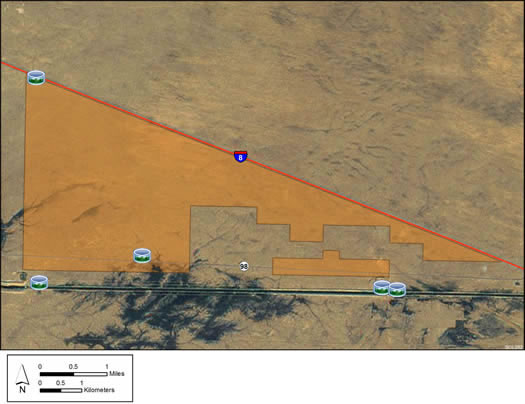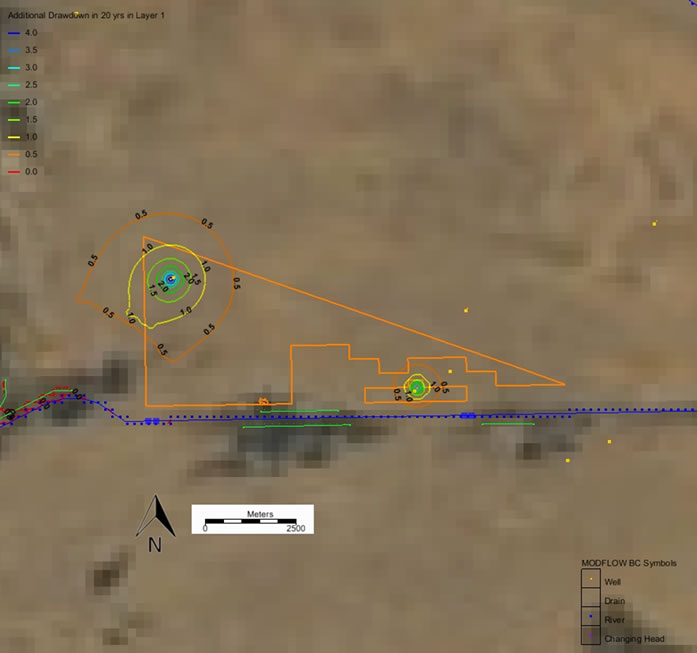The Approved Record of Decision for Resource Management Plan Amendments for Utility-Scale Solar Energy Development was issued on December 20th, 2024 — details are available on the BLM's Utility-Scale Solar Energy Development PEIS/RMPA webpage. Relevant information on the 2024 Western Solar Plan and the BLM's Renewable Energy Rule issued in July 2024, is in the process of being updated on this website.
| California Variance Areas | Imperial East SEZ |
 |
 |
The Imperial East Solar Energy Zone (SEZ) is a designated leasing area (DLA) located in California in gravel flats within the Sonoran Desert. The SEZ is located on BLM-administered land within the El Centro Field Office.
The Imperial East SEZ as proposed in the 2010 Draft Solar PEIS had a total area of 5,722 acres (23 km2). In the 2011 Supplement to the Draft Solar PEIS, 5 acres (0.02 km2) of wetlands along the southern border of the SEZ were identified as non-development areas, leaving the SEZ with a potentially developable area of 5,717 acres (23.1 km2). No additional changes were made to the SEZ developable area in the 2012 Final Solar PEIS.
The Imperial East SEZ is located in Imperial County in southeastern California, near the United States-Mexico border. The SEZ lies in East Mesa, within the California Desert Conservation Area (CDCA) and the Sonoran Desert. In 2008, the county population was 180,493, while the surrounding two-county region in Imperial County and Yuma County, Arizona had a total population of 387,798.

Scrubland vegetation reflects the arid climate. Much of the SEZ is covered with creosote flats consisting of generally tall, widely spaced creosotebushes on gravel. The south-central portion contains a more dense and diverse set of shrubs, with some small trees and a few palm trees. The Imperial Valley groundwater basin underlies the area. Annual rainfall averages about 3 to 4 in. (8 to 10 cm).
In addition to State Route 98, several gravel and dirt roads cross the SEZ, as well as several transmission lines. Communication and camera towers are also visible from much of the SEZ.
There is an operating geothermal plant about 3 mi (4.8 km) northwest of the SEZ. Little other commercial or industrial activity exists in the surrounding area, while agricultural areas lie about 3 mi (5 km) to the west, across the border in Mexico.

I-8 runs east-west along the northeast edge of the SEZ, while State Route 98, a two-lane highway, passes through the southern edge. The All-American Canal runs parallel to the southern boundary of the SEZ, about 0.3 mi (0.5 km) from the boundary. Two hydropower facilities exist along the canal, along with associated dams and substations.
A 115-kV transmission line intersects the southwest corner of the SEZ, and a 500‑kV line is located about 0.4 mi (0.6 km) to the south, running east-west.
In the 2012 Solar PEIS, the BLM committed to establishing a monitoring and adaptive management strategy for each solar energy zone (SEZ). Through these strategies, the BLM will take an active role in the collection of baseline data for the SEZs.
The BLM has not yet begun the monitoring and adaptive management strategy for the Imperial East SEZ. However, the BLM has conducted a pilot monitoring and adaptive management strategy for the Riverside East SEZ. In May 2016, the BLM released the Riverside East Solar Energy Zone Long Term Monitoring Strategy Final Report. The monitoring strategy document (PDF, 16.6 MB) is now available.
In the 2012 Solar PEIS, the Bureau of Land Management (BLM) committed to establishing a solar regional mitigation strategy for each solar energy zone (SEZ). These regional mitigation strategies are expected to simplify and improve the mitigation process for future solar projects in SEZs.
The BLM has completed regional mitigation strategies for the Arizona SEZs, the Colorado SEZs, and the Dry Lake and Dry Lake Valley North SEZs in Nevada. The Desert Renewable Energy Conservation Plan (DRECP) Land Use Plan Amendment (finalized in September 2016) provides the mitigation strategy for renewable energy development throughout the southern California desert as a whole, including the California SEZs (Imperial East, Riverside East, and West Chocolate Mountains SEZs). Details of the strategy identified by the DRECP Land Use Plan Amendment are provided in the Final BLM DRECP Land Use Plan and Environmental Impact Statement, Volume VI.
The purpose of the Imperial East Model is to assess potential impacts associated with groundwater withdrawals to support solar energy development in the vicinity of the Imperial East SEZ.

The Imperial East SEZ model is a model developed using public-domain geologic, hydrogeologic, and well pumping information and relying on the U.S. Geological Survey's MODFLOW 2000 code. It is a modification of the non-calibrated Tompson et al. (2008) model of the Imperial and Mexicali Valleys. Pre- and post-processing was performed using Groundwater Modeling System (GMS) version 9. In the first stage of the modeling, calibration of hydraulic conductivity and recharge was performed relying on pre-development, pre-canal steady-state water levels. Next, transient modeling was performed to calibrate water level changes due to municipal and agricultural water usage and the effects of irrigation canals. Finally, current pumping continued for 20 years into the future and included SEZ pumping to evaluate the effect of SEZ water requirements on groundwater drawdown.
Argonne National Laboratory's Division of Environmental Science staff constructed the Imperial East groundwater model, which received independent peer-review and review by BLM hydrology staff.
The Imperial East Model report has further information regarding its development and results.
The Imperial East Model files are contained in several .zip files. Please see model report (Section 5.4) for a description of the model files. Please Note: These files are large and may involve long download times.
Note: Modeling was performed using GMS version 9.0 (64-bit) with a build date of March 25, 2013. The files are packaged in several .zip files. When unzipped, they may be useable by older or newer versions of GMS or by other commercial graphical user interfaces; however, functionality cannot be guaranteed.
Alterations to the Imperial East Model could be made with the incorporation of new data regarding the hydrogeological framework and aquifer parameter values. As projects are planned, constructed, and begin operations, additional groundwater pumping scenarios can be analyzed and new data on head observations in monitoring wells can be used to refine the model.
For questions regarding the Imperial East Model, please contact John Quinn.